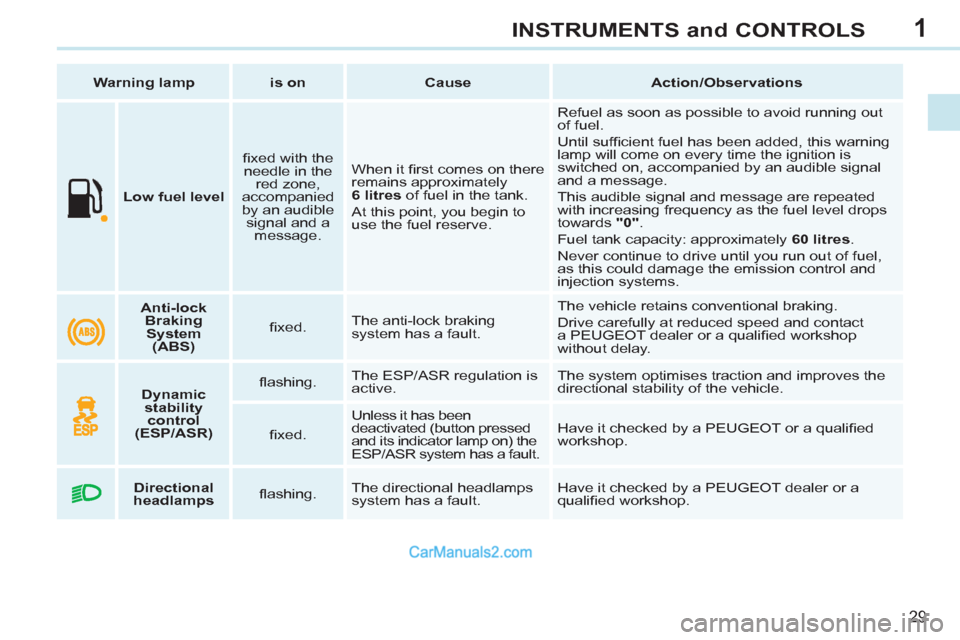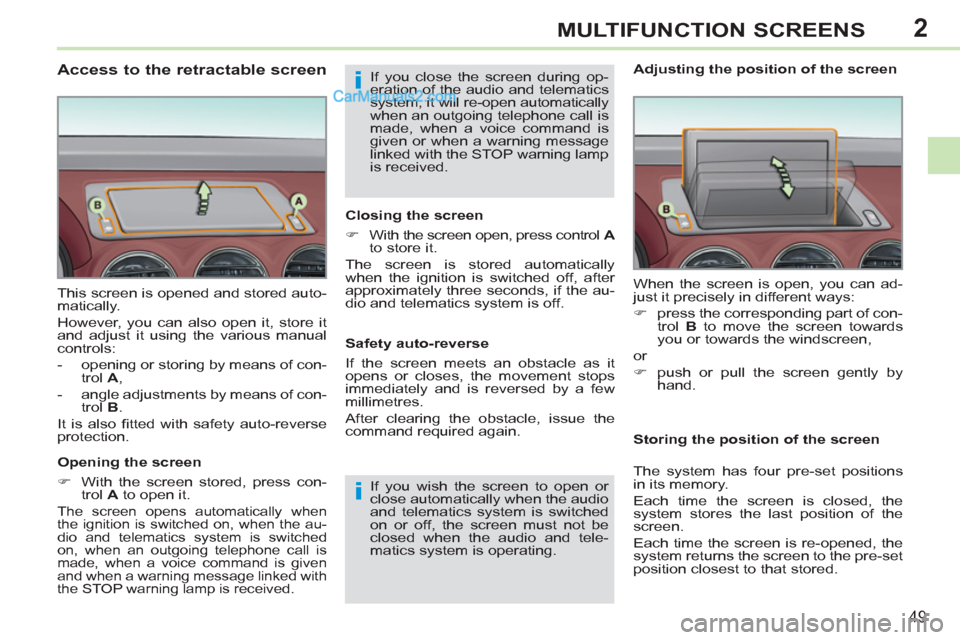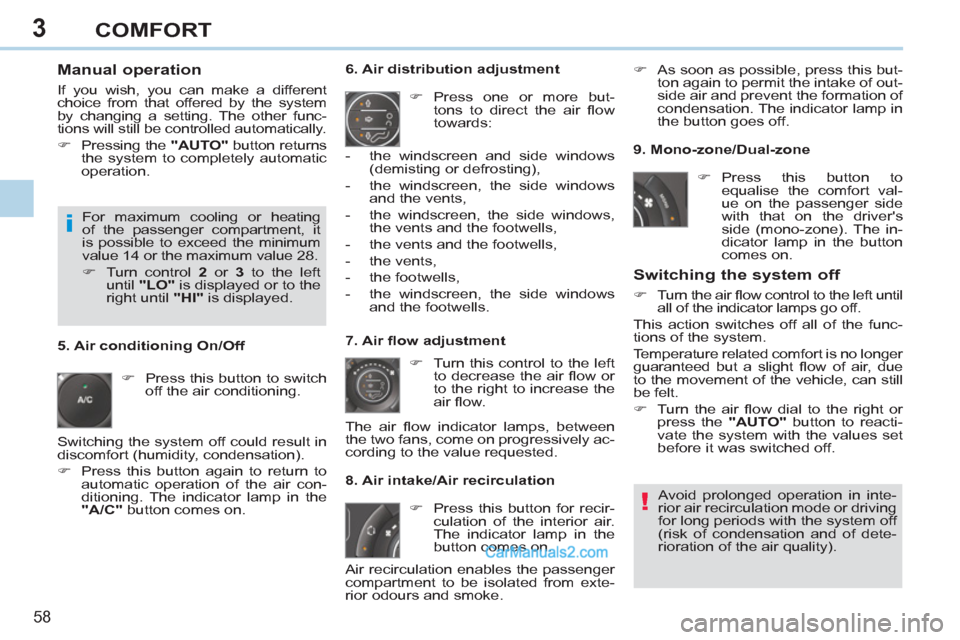2011 Peugeot 308 CC tow
[x] Cancel search: towPage 5 of 292

3
CONTENTS
Direction indicators 101
Hazard warning lamps 101
Horn 102
Emergency or assistance call 102
Tyre under-infl ation detection 103
Braking assistance systems 104
Trajectory control systems 105
Front seat belts 107
Airbags 110
Child seats 114
ISOFIX child seats 119�„
�„
�„
�„
�„
�„
�„
�„
�„
�„
�„
SAFETY 101 �Π121
Parking brake 122
Manual gearbox 122
Gear shift indicator 123
Hill start assist 124
Automatic gearbox 125
Stop & Start 128
Speed limiter 131
Cruise control 133
Parking sensors 135�„
�„
�„
�„
�„
�„
�„
�„
�„
DRIVING 122 �Π136
Bonnet 138
Running out of fuel (Diesel) 139
Petrol engines 140
Diesel engines 141
Checking levels 142
Checks 144�„
�„
�„
�„
�„
�„
CHECKS 137 �Π145
Temporary puncture repair kit 146
Changing a wheel 151
Changing a bulb 155
Changing a fuse 160
Battery 166
Energy economy mode 168
Changing a wiper blade 169
Towing the vehicle 169
Towing a trailer 171
Very cold climate screen 172
Accessories 172�„
�„
�„
�„
�„
�„
�„
�„
�„
�„
�„
PRACTICAL
INFORMATION 146 �Π173
Petrol engines 174
Weights (petrol) 175
Diesel engines 176
Weights (Diesel) 177
Dimensions 178
Identifi cation markings 179�„
�„
�„
�„
�„
�„
TECHNICAL
DATA 174 �Π180
AUDIO EQUIPMENT
and TELEMATICS 181 �Π278
VISUAL
SEARCH 279 �Π282
ALPHABETICAL
INDEX 283 �Π287
Emergency or assistance 181
Peugeot Connect Media 185
Peugeot Connect Navigation 229
Peugeot Connect Sound 261�„
�„
�„
�„
7
89
1011
Page 22 of 292

20
ECO-DRIVING
Eco-driving is a range of everyday practices that allow the motorist to optimise their fuel consumption and CO2 emissions.
Optimise the use of your
gearbox
With a manual gearbox, move off gen-
tly, change up without waiting and
drive by changing up quite soon. If
your vehicle has the system, the gear
shift indicator invites you to change up;
it is displayed in the instrument panel,
follow its instructions.
With an automatic or electronic gear-
box, stay in Drive "D"
or Auto "A"
,
according to the type of gear selector,
without pressing the accelerator pedal
heavily or suddenly.
Drive smoothly
Maintain a safe distance between vehi-
cles, use engine braking rather than the
brake pedal, and press the accelerator
progressively. These attitudes contribute
towards a reduction in fuel consumption
and CO
2 emissions and also helps re-
duce the background traffi c noise.
When the traffi c is fl owing well, and if
you have cruise control, make use of
the system at speeds above 25 mph
(40 km/h).
Control the use of your
electrical equipment
Before moving off, if the passenger
compartment is too warm, ventilate it by
opening the windows and air vents be-
fore using the air conditioning.
Above 30 mph (50 km/h), close the win-
dows and leave the air vents open.
Remember to make use of equipment
that can help keep the temperature in
the passenger compartment down (sun
roof and window blinds...).
Switch off the air conditioning, unless
it has automatic digital regulation, as
soon as the desired temperature is at-
tained.
Switch off the demisting and defrosting
controls, if not automatic.
Switch off the heated seat as soon as
possible.
Switch off the headlamps and front
foglamps when the level of light does
not require their use.
Avoid running the engine before moving
off, particularly in winter; your vehicle will
warm up much faster while driving.
As a passenger, if you avoid connecting
your multimedia devices (fi lm, music, vid-
eo game...), you will contribute towards
limiting the consumption of electrical en-
ergy, and so of fuel.
Disconnect your portable devices be-
fore leaving the vehicle.
Page 31 of 292

1
29
INSTRUMENTS and CONTROLS
Low fuel level
fi xed with the
needle in the
red zone,
accompanied
by an audible
signal and a
message. When it fi rst comes on there
remains approximately
6 litres
of fuel in the tank.
At this point, you begin to
use the fuel reserve. Refuel as soon as possible to avoid running out
of fuel.
Until suffi cient fuel has been added, this warning
lamp will come on every time the ignition is
switched on, accompanied by an audible signal
and a message.
This audible signal and message are repeated
with increasing frequency as the fuel level drops
towards "0"
.
Fuel tank capacity: approximately 60 litres
.
Never continue to drive until you run out of fuel,
as this could damage the emission control and
injection systems.
Warning lamp
is on
Cause
Action/Observations
Anti-lock
Braking
System
(ABS)
fi xed. The anti-lock braking
system has a fault. The vehicle retains conventional braking.
Drive carefully at reduced speed and contact
a PEUGEOT dealer or a qualifi ed workshop
without delay.
Dynamic
stability
control
(ESP/ASR)
fl ashing. The ESP/ASR regulation is
active. The system optimises traction and improves the
directional stability of the vehicle.
fi xed. Unless it has been
deactivated (button pressed
and its indicator lamp on) the
ESP/ASR system has a fault. Have it checked by a PEUGEOT or a qualifi ed
workshop.
Directional
headlamps
fl ashing. The directional headlamps
system has a fault. Have it checked by a PEUGEOT dealer or a
qualifi ed workshop.
Page 35 of 292

1
33
INSTRUMENTS and CONTROLS
Warning lamp
is on
Cause
Action/Observations
Front
foglamps
fi xed. The front foglamps are
switched on. Turn the ring on the stalk rearwards twice to
switch off the front foglamps.
Rear
foglamps
fi xed. The rear foglamps are
switched on. Turn the ring on the stalk rearwards to switch off
the rear foglamps.
Diesel engine
pre-heating
fi xed. The ignition switch is at the
2nd position (ignition on).
Wait until the warning lamp has switched off before starting.
The duration for which the warning lamp is on is
determined by the climatic conditions.
Stop & Start
fi xed. When the vehicle stops (red
lights, traffi c jams, ...) the
Stop & Start system has
put the engine into STOP
mode. The warning lamp goes off and the engine
restarts automatically in START mode, as soon
as you want to move off.
fl ashes for a
few seconds,
then goes off. STOP mode is temporarily
unavailable.
or
START mode is invoked
automatically. Refer to "Driving - § Stop & Start" for special
cases with STOP mode and START mode.
Dipped beam
headlamps
fi xed. The lighting stalk is in the
"Dipped beam headlamps"
position or in the "AUTO"
position in conditions of low
light.
Main beam
headlamps
fi xed. The lighting stalk is pulled
towards you. Pull the stalk again to return to dipped beam
headlamps.
Page 51 of 292

2
i
i
49
MULTIFUNCTION SCREENS
Access to the retractable screen
Opening the screen
�)
With the screen stored, press con-
trol A
to open it.
The screen opens automatically when
the ignition is switched on, when the au-
dio and telematics system is switched
on, when an outgoing telephone call is
made, when a voice command is given
and when a warning message linked with
the STOP warning lamp is received.
This screen is opened and stored auto-
matically.
However, you can also open it, store it
and adjust it using the various manual
controls:
- opening or storing by means of con-
trol A
,
- angle adjustments by means of con-
trol B
.
It is also fi tted with safety auto-reverse
protection.
Closing the screen
�)
With the screen open, press control A
to store it.
The screen is stored automatically
when the ignition is switched off, after
approximately three seconds, if the au-
dio and telematics system is off.
If you wish the screen to open or
close automatically when the audio
and telematics system is switched
on or off, the screen must not be
closed when the audio and tele-
matics system is operating. When the screen is open, you can ad-
just it precisely in different ways:
�)
press the corresponding part of con-
trol B
to move the screen towards
you or towards the windscreen,
or
�)
push or pull the screen gently by
hand.
Adjusting the position of the screen
Safety auto-reverse
If the screen meets an obstacle as it
opens or closes, the movement stops
immediately and is reversed by a few
millimetres.
After clearing the obstacle, issue the
command required again.
Storing the position of the screen
The system has four pre-set positions
in its memory.
Each time the screen is closed, the
system stores the last position of the
screen.
Each time the screen is re-opened, the
system returns the screen to the pre-set
position closest to that stored.
If you close the screen during op-
eration of the audio and telematics
system, it will re-open automatically
when an outgoing telephone call is
made, when a voice command is
given or when a warning message
linked with the STOP warning lamp
is received.
Page 56 of 292

3
i
i
54
COMFORT
The condensation created by the
air conditioning results in a dis-
charge of water under the vehicle
which is perfectly normal.
RECOMMENDATIONS FOR VENTILATION AND AIR
CONDITIONING
In order for these systems to be fully effective, follow the guidelines on
operation and maintenance below:
�)
To obtain an even air distribution, take care not to obstruct the exterior air
intake grilles located at the base of the windscreen, the nozzles, the vents
and the air outlets, as well as the air extractor located in the boot.
�)
Do not cover the sunshine sensor, located on the dashboard; this is used
for regulation of the air conditioning system.
�)
Operate the air conditioning system for 5 to 10 minutes, once or twice a
month to keep it in perfect working order.
�)
Ensure that the passenger compartment fi lter is in good condition and
have the fi lter elements replaced regularly (refer to the "Checks" section).
�)
We recommend the use of a combined passenger compartment fi lter. Thanks
to its second special active fi lter, it contributes to the purifi cation of the air
breathed by the occupants and the cleanness of the passenger compartment
(reduction of allergic symptoms, bad odours and greasy deposits).
�)
To guarantee correct operation of the air conditioning system, you are also
advised to have it checked regularly.
�)
If the system does not produce cold air, do not use it and contact a
PEUGEOT dealer or a qualifi ed workshop.
In the "cabriolet" confi guration, installing the windstop and using the "AIRWAVE"
systems improves comfort.
When towing the maximum load on a steep gradient in high temperatures,
switching off the air conditioning permits the recovery of engine power and
therefore improvement of the towing capacity.
If the interior temperature remains
very high after the vehicle has been
parked in the sun for a considerable
time, fi rst ventilate the passenger
compartment for a few minutes.
Place the air fl ow control at a suf-
fi cient level to provide an adequate
renewal of air in the passenger
compartment.
The air conditioning system does
not contain chlorine and does not
present any danger to the ozone
layer.
Stop & Start
The heating and air conditioning systems only work when the engine is running.
To maintain a comfortable temperature in the passenger compartment, you
can temporarily deactivate the Stop & Start system (see "Driving").
Page 60 of 292

3
!
i
58
COMFORT
Manual operation
If you wish, you can make a different
choice from that offered by the system
by changing a setting. The other func-
tions will still be controlled automatically.
�)
Pressing the "AUTO"
button returns
the system to completely automatic
operation.
�)
Press this button to switch
off the air conditioning.
6. Air distribution adjustment
�)
Press one or more but-
tons to direct the air fl ow
towards:
7. Air fl ow adjustment
�)
Turn this control to the left
to decrease the air fl ow or
to the right to increase the
air fl ow.
8. Air intake/Air recirculation
Switching the system off
�)
Turn the air fl ow control to the left until
all of the indicator lamps go off.
This action switches off all of the func-
tions of the system.
Temperature related comfort is no longer
guaranteed but a slight fl ow of air, due
to the movement of the vehicle, can still
be felt.
�)
Turn the air fl ow dial to the right or
press the "AUTO"
button to reacti-
vate the system with the values set
before it was switched off.
�)
Press this button for recir-
culation of the interior air.
The indicator lamp in the
button comes on.
5. Air conditioning On/Off
Avoid prolonged operation in inte-
rior air recirculation mode or driving
for long periods with the system off
(risk of condensation and of dete-
rioration of the air quality).
- the windscreen and side windows
(demisting or defrosting),
- the windscreen, the side windows
and the vents,
- the windscreen, the side windows,
the vents and the footwells,
- the vents and the footwells,
- the vents,
- the footwells,
- the windscreen, the side windows
and the footwells.
The air fl ow indicator lamps, between
the two fans, come on progressively ac-
cording to the value requested.
�)
As soon as possible, press this but-
ton again to permit the intake of out-
side air and prevent the formation of
condensation. The indicator lamp in
the button goes off.
For maximum cooling or heating
of the passenger compartment, it
is possible to exceed the minimum
value 14 or the maximum value 28.
�)
Turn control 2
or 3
to the left
until "LO"
is displayed or to the
right until "HI"
is displayed.
9. Mono-zone/Dual-zone
�)
Press this button to
equalise the comfort val-
ue on the passenger side
with that on the driver's
side (mono-zone). The in-
dicator lamp in the button
comes on.
Air recirculation enables the passenger
compartment to be isolated from exte-
rior odours and smoke.
Switching the system off could result in
discomfort (humidity, condensation).
�)
Press this button again to return to
automatic operation of the air con-
ditioning. The indicator lamp in the
"A/C"
button comes on.
Page 63 of 292

3
61
COMFORT
�)
Pull the windstop forwards to re-
lease the guides from the points,
located behind each corner of the
back of the rear bench seat.
�)
Fold the windstop frame guides.
Storing
In the storage box (version
equipped with a temporary tyre
repair kit)
�)
Raise the boot carpet and hook its
handle on the boot seal.
�)
Store the folded windstop in the cor-
responding recess in the box.
�)
Lower the boot carpet.
In the boot (version equipped with a
spare wheel)
�)
Stow the folded windstop securing it
using the luggage retaining net.
�)
Fold the windstop closing the
two large parts on themselves.
�)
Unclip each end individually.
�)
Fold each of the two parts on them-
selves.